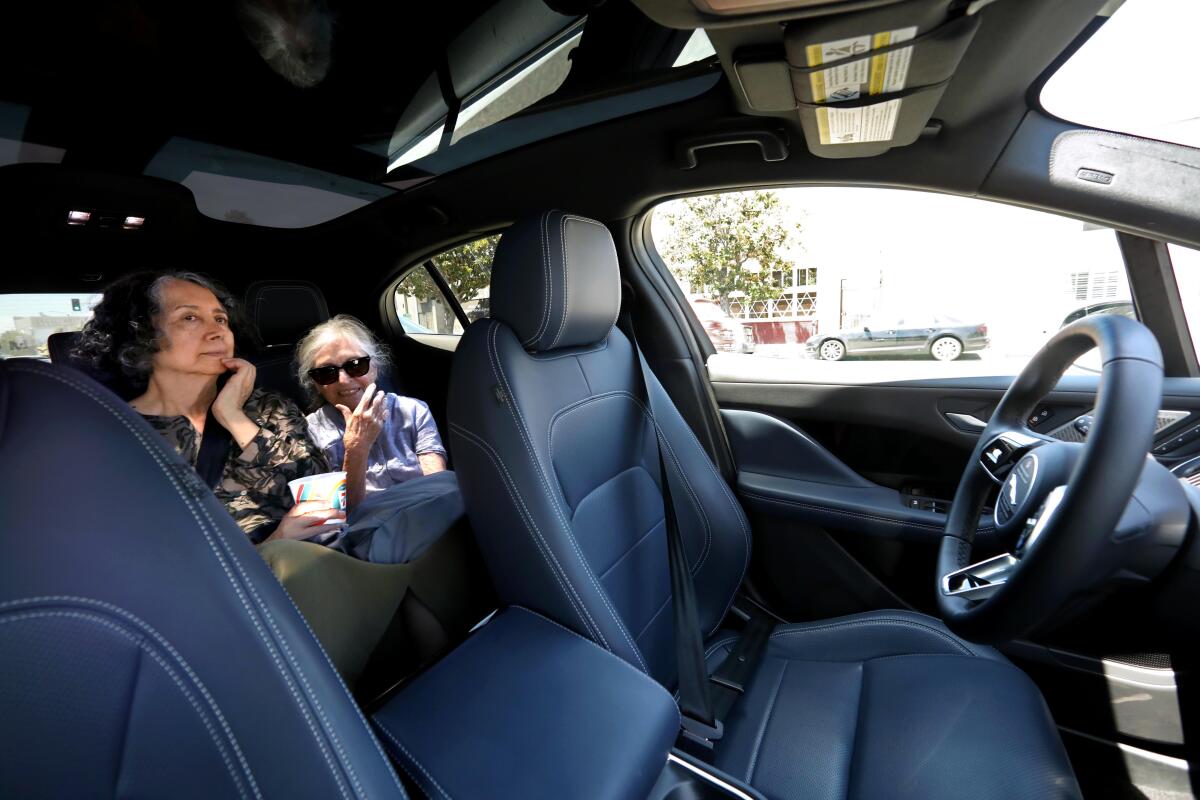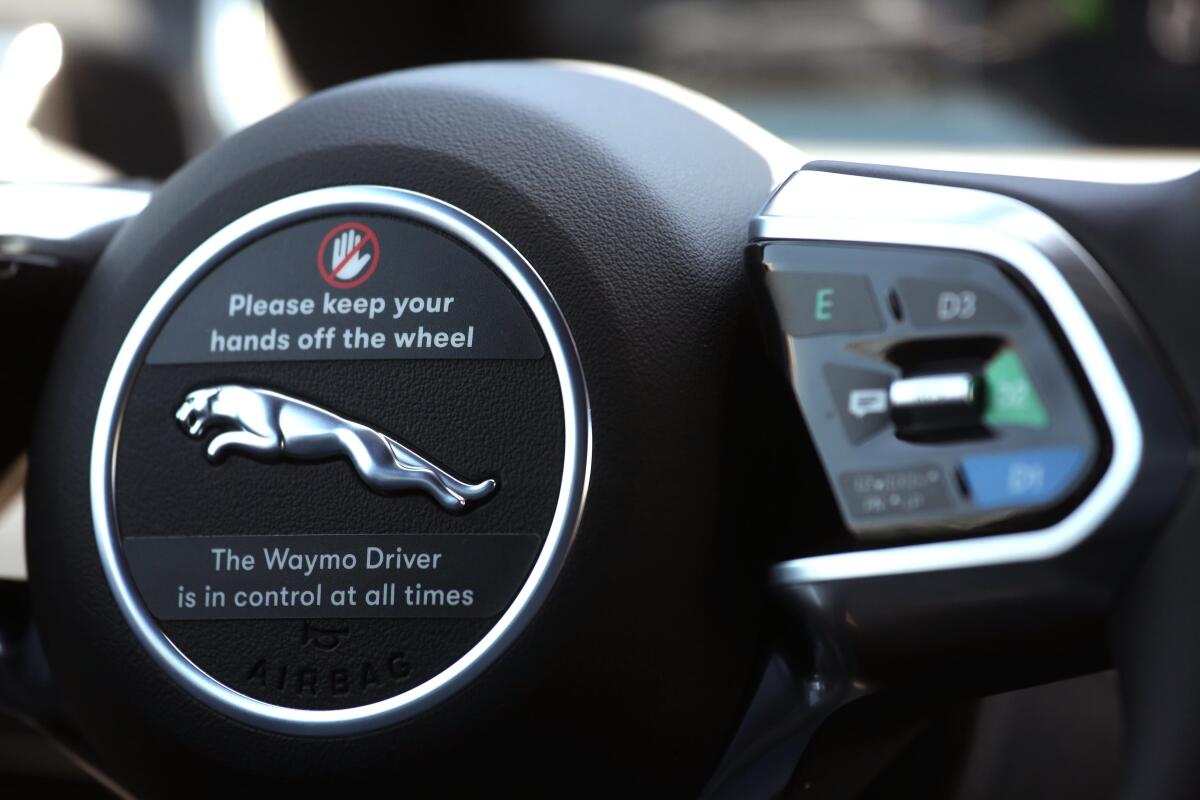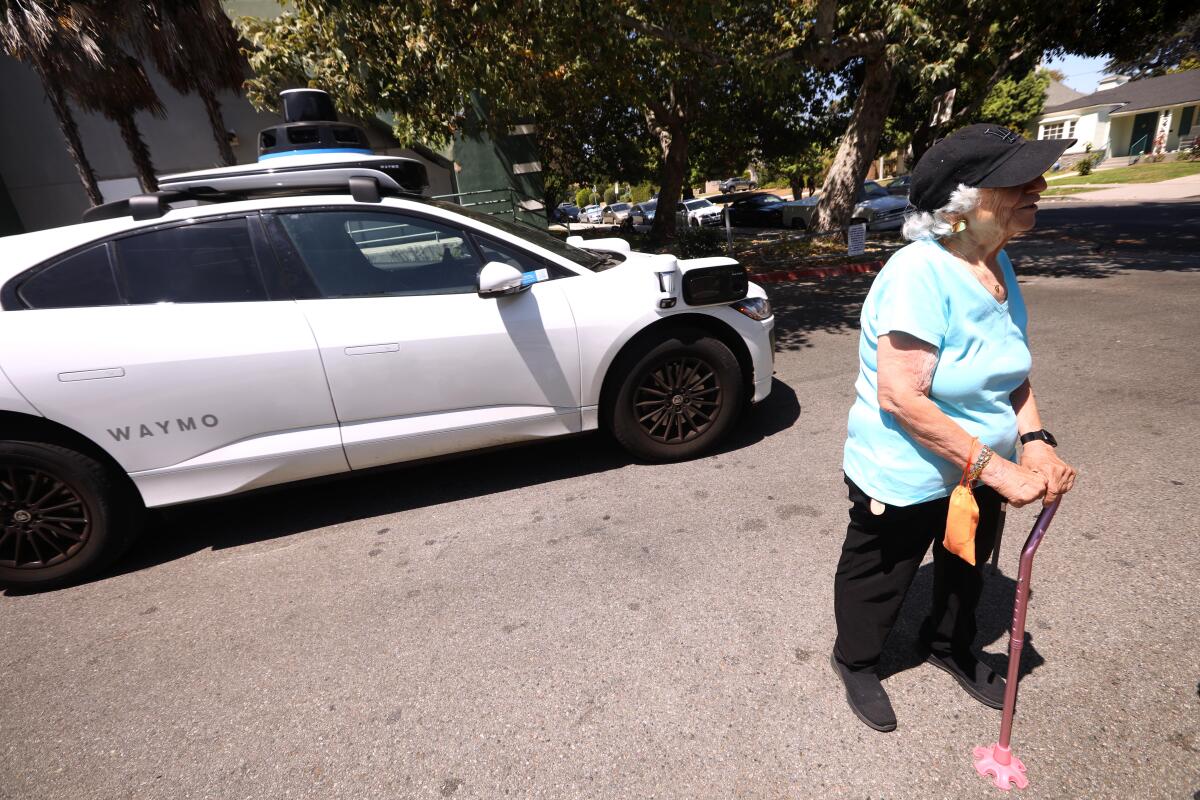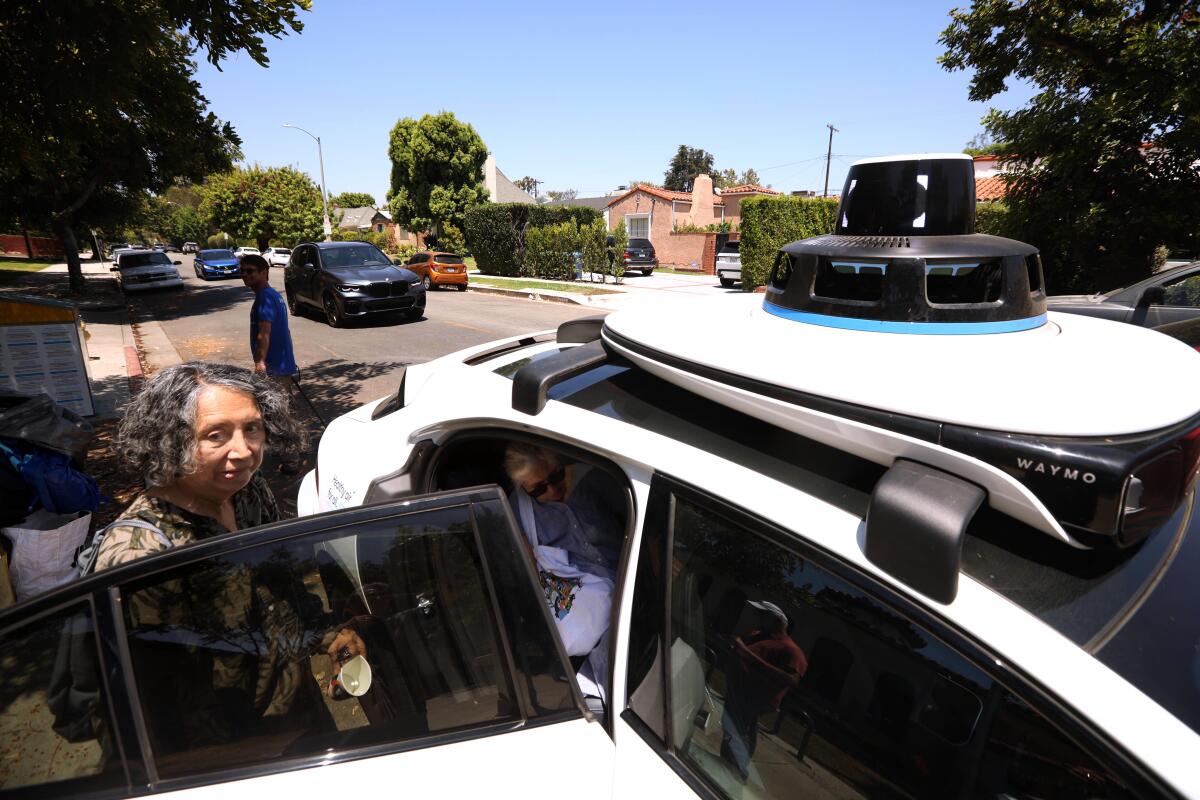If a driverless taxi pulls up to a senior center, will anyone brave a ride?

- Share via
I was headed west on 3rd Street from a mid-city senior center with 89-year-old Julie Finger, who showed no sign of fear. Our ride wasn’t just any old car; it was a fully loaded electric Jaguar, and among other details worth sharing, one in particular stands out.
There was no driver.
Midday traffic was moderate, we were doing about 25 mph, the vehicle (which starts in the $70,000 range) smoothly accelerated and braked, and the steering wheel turned to the left and turned to the right, but allow me to repeat:
There was no driver.
Are you the least bit nervous? I asked Finger.
“No,” she said with a giggle. “It’s very exciting.”
Our robotaxi service was Waymo, the Google autonomous vehicle company that has fleets in San Francisco and Phoenix and began limited service in Los Angeles this spring in a 63-square-mile area between downtown L.A. and the beach.
California is about to be hit by an aging population wave, and Steve Lopez is riding it. His column focuses on the blessings and burdens of advancing age — and how some folks are challenging the stigma associated with older adults.
A Waymo spokesperson said there’s a small number of their vehicles on the road in L.A., but the plan is to scale up as soon as possible. Fifty thousand people are on a waiting list to have their ride-hailing apps activated.
At first, my Waymo ride felt unsettling; blind faith, after all, takes some getting used to. As the car pulled away from the curb, I found myself craning to see if it was safe, and, instinctively, I wanted to tell the “driver” to watch out for this or that.
But Finger, a retired graphic artist, wasn’t sweating it. This was her third ride in a driverless vehicle, and she had a smile on her face as we cruised in air-conditioned comfort.
::
I’d been wondering if robotaxis might catch on with older adults.

As we age, we eventually hit a point where we need to lock away the car keys. (Finger felt uncomfortable behind the wheel about 10 years ago and gave her Toyota to her grandson.) Public transit is not always convenient, and lately it feels risky. As for taxis, Lyft and Uber, not everyone is comfortable getting into vehicles driven by strangers.
A Waymo spokesperson said the company didn’t have current demographics but told me seniors in Phoenix — some with vision problems or other disabilities — have been using the robotaxis for grocery shopping and date night — and to impress visiting grandchildren.
In Los Angeles, Waymo has been working with “an array of senior organizations” to pitch robotaxis as one solution to the mobility challenge and, perhaps, the epidemic of isolation that I’ve written about before.
Waymo hooked me up with Finger, who moved to the U.S. from India at the age of 20, and her friend Bill Meyerchak, 47, a volunteer at the Fairfax Senior Citizens Center. A tech-savvy former banker who wrecked his back 10 years ago moving heavy furniture, Meyerchak, who uses a cane, has already taken more than 50 Waymo rides and has been encouraging clients at the center to give it a try.
One day, after a game of bingo, Finger was ready to head home and Meyerchak suggested she try Waymo. He used his app to call for a car, accompanied Finger on her ride home, and she was sold.

“Maybe the technology is what appeals to me,” Finger said, and “the fact that I like new things. When Bill showed me, oh, you can press this button and listen to music, or you can press this button and talk to a real person [a customer service advisor], I thought it was exciting.”
But did she have any qualms about the empty driver’s seat, or the possibility that the ghost behind the wheel might plow into a tree?
“It’s probably safer,” she said, because humans make mistakes.
As my colleague Rachel Uranga reported, Waymo said last year that a study indicated its crash rate was 85% lower than that of humans. But there hasn’t been a great deal of safety data compiled yet by market watchers or regulatory agencies.
The National Highway Traffic Safety Administration has investigated a couple dozen incidents involving autonomous vehicles and collisions. Driverless cars have hit a truck, a cyclist, a gate, a pole and a few other things, mostly in minor incidents.
The robocars do have some big safety advantages, though: No drunk driving, no texting while driving, no falling asleep while driving, no road rage while driving.
::
In a region with millions of vehicles competing for space each day in L.A., hailing one without a driver strikes some people as crazy. I picked up on that outside the Pan Pacific Senior Activity Center, where Meyerchak and Finger have been spending time lately. Israel Brettler, who was just leaving the center, said it was unlikely that he’d willingly get into a driverless vehicle. Sharon Boaz was more direct about it. “No, thank you,” she said. “I don’t trust those.”
Finger went to work on her, though, and after a few minutes Boaz, 77, was ready to throw caution to the wind.
“I was talked into it by my good friend here, who has more courage than I do,” Boaz said.

Farah Javadi, 74, was strolling by when we asked if she’d like to join us. She seemed a bit wary at first, but decided she didn’t want to miss out on the fun. (Anyone who thinks this age group is tech-averse, or done with adventure, should spend a few weeks with me on the Golden State beat.)
I called for a Waymo, and it arrived in several minutes looking like the offspring of an SUV and a robot, its rooftop outfitted with a Light Detection and Ranging system and perimeter sensors that looked like bulging eyeballs.
“Happy Friday,” said an automated voice as we climbed in. I punched in Farmers Market as our destination, roughly a mile away, and our Waymo pulled away from the curb.
“Unbelievable,” Javadi said. “Wow!”
“I’m here, I’m buckled up … and all is right with the world,” Boaz said, although she worried about all the drivers who might lose their jobs.
“If I want to sing, I can sing,” Javadi said. “I won’t have to be embarrassed that a driver can hear me.”
That may have been the thinking of the couples who used their robotaxis as motel rooms in San Francisco, only to later discover the cars have audio and video recording capabilities. On my ride with Boaz and Javadi, a Waymo operator suddenly joined us on the audio system, not to inform us that hanky-panky is prohibited, but to say that two passengers did not have their seat belts fastened.
That’s commendable, but here’s a complaint: In two separate rides, one with Boaz and Javadi and the other with Finger and Meyerchak, Waymo failed to deliver us to our requested location : The Original Farmers Market.
As we approached, instead of turning right on the road that runs between Farmers Market and The Grove — South Gilmore Lane — our car turned left, crossing to the wrong side of 3rd Street and onto Ogden Drive, where it came to a halt. Not at a curb, or in an intersection, or in an open parking lot a few feet away, but in the middle of the road, next to a construction site.
It wasn’t a safe place for anyone, young or old, to exit the car. And though we were close to Farmers Market, we’d have to cross busy 3rd Street on foot to get there. We were stuck there for a few minutes while I punched in a new destination and a construction worker tried to wave us forward.
Afterward, a Waymo representative thanked me for reporting the problem and said the company is working out kinks like these before expanding service in L.A.
Meyerchak told me there’s a feature on the app to limit walking distance from your drop-off point and said he’s confident that service will improve and robotaxis will become a source of freedom for older and disabled people.

With regular ride-hailing services, Meyerchak has found that some drivers don’t want to pick up seniors or disabled people. Maybe, he said, it’s because they need some extra time or some help with walkers, or because they use subsidized ride vouchers that pay below market rates.
“This is my favorite thing about Waymo,” Meyerchak said. “It doesn’t discriminate against seniors, or race or ethnicity.”
It isn’t cheap, if you were wondering. Meyerchak estimated he pays a bit more than Uber’s base rate and a bit less than its premium fare. The day before I rode with him, my two trips of 1.7 miles cost $8.70 apiece. But you don’t have to tip the robot.
So, would I recommend it?
I think so, but only if Waymo works out the drop-off glitches. And I do have a few questions:
If you’re trying to change lanes and a $70,000 Jaguar without a driver won’t let you merge, what good is having a middle finger in L.A.?
How long until some knucklehead steals a bag of doughnuts, hops into a Waymo and leads police and squadrons of helicopters on a driverless car chase?
And if one tech hiccup could ground thousands of flights and overwhelm airports, could a different tech glitch steer your robotaxi off the Santa Monica Pier and into the surf?
Finger did not share my concerns. During our ride, she wanted to hear some classical music, and Meyerchak guided me through the stereo system. It’s as if you’re in your own sanctuary, he said. You control the music, the windows, the air conditioning.
We were heading west on 3rd Street.
Ravel’s “Spanish Rhapsody” was playing.
And Finger declared it “awesome.”
steve.lopez@latimes.com
More to Read
Sign up for Essential California
The most important California stories and recommendations in your inbox every morning.
You may occasionally receive promotional content from the Los Angeles Times.











